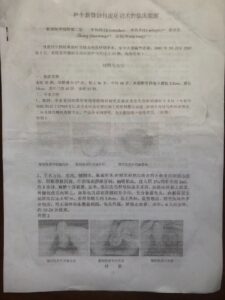Surgical paper XX
Clinical observation of a new minimally invasive circumcision
Introduction
The classical treatment for excessive foreskin has long been surgical circumcision, with little breakthroughs in recent years. From October 2003 to February 2005, our hospital treated 52 cases of excessive foreskin using a minimally invasive surgical technique. Here we present the findings.
Materials and Methods
Clinical Data
The study included 52 patients, with ages ranging from 17 to 56 years and an average age of 38 years. Preoperative measurements of the penis in a flaccid state ranged from 2.5 cm to 10 cm. Of these, 40 were married and 12 were unmarried.
Surgical Technique
- Materials: The procedure utilizes a minimally invasive surgical ring invented by Mr. Shang Jianzhong, a special researcher at the Chinese Academy of Management Sciences (Patent No. 2003.ZL02 237969.X). The surgical ring is made from injection-molded polypropylene engineering plastic and consists of an inner and outer ring. The two rings are secured together using screws. The product comes in various sizes and is for one-time use in sterile packaging.
Attached Figure 1: Inner Ring of the Minimally Invasive Foreskin Cutter, Outer Ring of the Minimally Invasive Foreskin Cutter, Complete Minimally Invasive Foreskin Cutter (See insert for illustration).

Methodology
-
Preparation: Sterilization is performed, and a hole towel is laid out to expose the penis. A rubber band tourniquet is placed around the base of the penis to block venous return. A distended vein is then punctured, stagnant blood is aspirated, and 2ml of 2% lidocaine is injected. After waiting for 5 minutes, anesthesia is found to be highly satisfactory and complete.
-
Ring Placement: An appropriately-sized surgical foreskin ring is chosen. The inner ring is first placed around the penis. The foreskin is then everted over the inner ring. If phimosis is present, a small incision is made on the dorsal side to fully expose the glans. The inner plate is retained up to 0.5 cm beyond the coronal sulcus, and the frenulum is left slightly longer, about 1.0 cm.
-
Outer Ring and Cutting: The outer ring is then placed and screws are tightened. Excess foreskin protruding beyond the compression ring is trimmed. A sterile gauze strip is used to cover the wound, leaving the glans exposed. The tourniquet is then released, completing the surgery.
-
Post-Operative Care: The ring is removed on the sixth day post-operation, and full recovery is generally achieved in approximately 15-20 days.
Attached Figure 2: Post-healing of Minimally Invasive Foreskin Surgery, Completion of Minimally Invasive Foreskin Surgery, Pre Minimally Invasive Foreskin Surgery (See above insert for illustration).
Results
Out of the 52 cases, primary wound healing was achieved in 50 cases post-operatively. In 2 cases, healing was delayed due to infection caused by engaging in sexual activity before the advised period. There were no long-term complications, and the healed wounds left no scars.
Discussion
Excessive foreskin length can lead to phimosis, where the coronal sulcus is not exposed, causing a buildup of secretions that cannot be eliminated, thereby leading to balanoposthitis. Long-term inflammation could even induce penile cancer. Phimosis can also result in poor penile development and impact sexual life. Excessive foreskin is a common issue plaguing male patients.
Minimally invasive foreskin ring resection is suitable for males with excessive foreskin and phimosis. Traditional treatment methods, such as full circumcision, involve cutting, hemostasis, and suturing, and often leave scars after healing; laser surgery also has drawbacks like thermal injury.
This innovative method breaks away from traditional approaches. It eliminates the need for surgical cutting and suturing. After the ring compresses the distal tissues, ischemia leads to tissue necrosis and eventual detachment, thus completing the circumcision. Generally, the ring is removed around the 6th day, and full recovery is achieved in approximately 15-20 days. The healed wounds leave no scars, and the surgery time is only 2-5 minutes. No additional medical equipment is needed, avoiding complicated hemostasis steps. The incidence of infection is low, no estrogen therapy is needed, and patients can move freely post-operatively. Daily life is not impacted; patients can bathe, urination is unaffected, and there are no complications.
Comparison of New Method and Traditional Methods
|
New Method |
Traditional (circumcision,laser) |
|
|
1、surgery |
micro, convenient, no pain, no scars |
invasive and complicated, with pains and scars |
|
2、resources |
one operator only |
at least 2 operators needed |
|
3、materials |
no need for surgery tool |
needs surgery tool in surgery room |
|
4、bleeding |
no bleeding |
bleeding |
|
5、procedure time |
less than 5 min |
more than 30 min |
|
6、cost |
low cost |
more cost |
In the 52 cases treated with this method, some patients experienced varying degrees of penile length and girth increase post-operatively, along with enhanced sexual function, due to the alleviation of the restrictions imposed by the foreskin.
Conclusion
This novel minimally invasive surgical approach is superior to traditional methods, with definite therapeutic effects. It is worthy of broader adoption.




本文原载…….???
Originally published in "???" 90; 4(3):66 by Li Yangzhen, Li Mingjie, Shang Jianzhong, Wang Tong
from 一种全新微创包皮环切术的临床观察